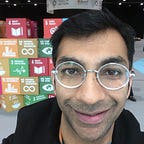The World Urban Forum: placing people and culture at the heart of the smart city
Last month, Abu Dhabi hosted the tenth session of the World Urban Forum (WUF), a conference that brings together thousands of urban practitioners globally to discuss how urbanisation can be transformed into a driving force for sustainability. With news of the COVID-19 virus emerging in China at this time, participation was limited to around 13 000 rather than the usual of 15–16000.
The theme for the conference was culture and innovation and so a perfect place to hear about how cities and communities across the globe are innovating to meet the many urban challenges that we face.
In this regard, the concept of the smart city was very apparent. During the first couple of days, as I bounded between meeting to panel to plenary session, I found myself rushing past the cavernous exhibition space, where organizations, could display their take on the WUF themes. The space was dominated by massive, flashy country and city stands, with the city of Moscow’s flashy neon display, literally putting all others into the shade. When I did have a minute to pop in, I found myself overwhelmed by more glitzy models of smart city districts, exuding digital chic, with 3-D modeling of high-rise skyscrapers and glass heavy architecture…and no people.
As the Forum progressed, there was a lot being presented about the possibilities of blockchain technology, big data, Artificial Intelligence, digital neighborhoods. But at the same time, these were balanced with issues of inclusion, good governance, gender perspectives, and service delivery. For example, when the Bangladesh government rolls out its 6000 government service stations, saving 1 billion visits to government offices, and 8.1 billion dollars in government fees, it does so using an empathy-based model of government service. And when Dubai developed its one-stop-shop website for government services, it did so using a website accessibility excellence model. In other words, innovation must look far beyond technology and mustn’t lose sight of aspects that can improve lives especially of the most vulnerable groups of society, such as the urban poor, women, children and indigenous groups.
This message was rammed home by UN HABITAT’s Secretary General Maimunah Mohd Sharif. She was particularly forthright in expressing her concerns about mainstream conceptions of smart cities. Those glitzy models are the very things that she wants to see changed. Smart cities need to be people focused, taking into account good quality urbanism such as nature-based solutions, planning at urban scale, and traditional water management models. She also warned of the growing digital divide, where women are less likely to use digital technologies, and issues of privacy and human rights which, if not addressed, threaten to derail progress towards the SDGs.
Luckily for Ms Sharif, there were plenty more examples of good quality urbanism emerging. WWF launched its plastics-smart cities platform and partnership with UN HABITAT to tackle plastic pollution in cities. I was involved on several panels, highlighting WWF’s innovative One Planet City Challenge model for guiding cities with meeting the Paris Agreement’s commitments and supporting their energy transitions — taken up in discussions on how to act on climate emergency declarations and help data-scarce cities with climate and disaster risk assessments.
I also took the opportunity to present the Viable Cities platform, for which WWF Sweden is a partner organisation. A typical reaction was that of course Sweden should really be at the forefront of transitioning its cities and they appreciated that the platform was putting people at the centre of its initiatives through for example Sharing Cities. There was enthusiasm to learn more, especially from local delegates from the Middle East region so watch out for aSaudi delegation reaching Swedish shores soon.
Cities also shared examples of circular economy innovations, with, for example Sao Paulo developing an organic urban farming model. The potential of nature based solutions was a key theme, with the megacity of Shenzhen in China used as an example of how a natural habitat coastal defense system can do a better job than a seawall, with knock-on benefits for eco-tourism and the fisheries sector.
After five days of panels, assemblies, side events, networking events and urban talks, on my last day in Abu Dhabi I stumbled back into the Exhibition Space, awaiting one of the last free guided tours that would rescue me from the confines of attending a six-day conference. This time I managed to make it past Moscow and found a plethora of stands and exhibits reflecting much more what had emerged from the sessions. India’s stand reflected how it is grappling with waste and pollution choking its Ganga-Yamuna river system while engaging locals to develop resilient communities, Abu Dhabi setting out its soil salinity management plan to stimulate urban farming practices, and the city of Penang in Malaysia’s use of nature-based solutions to bolster resilience. Reinvigorated and filled with optimism about how the urban community is moving forward to drive innovation beyond a strictly technology-centric focus, I stepped onto the tour bus and noted its destination: Masdar City.
